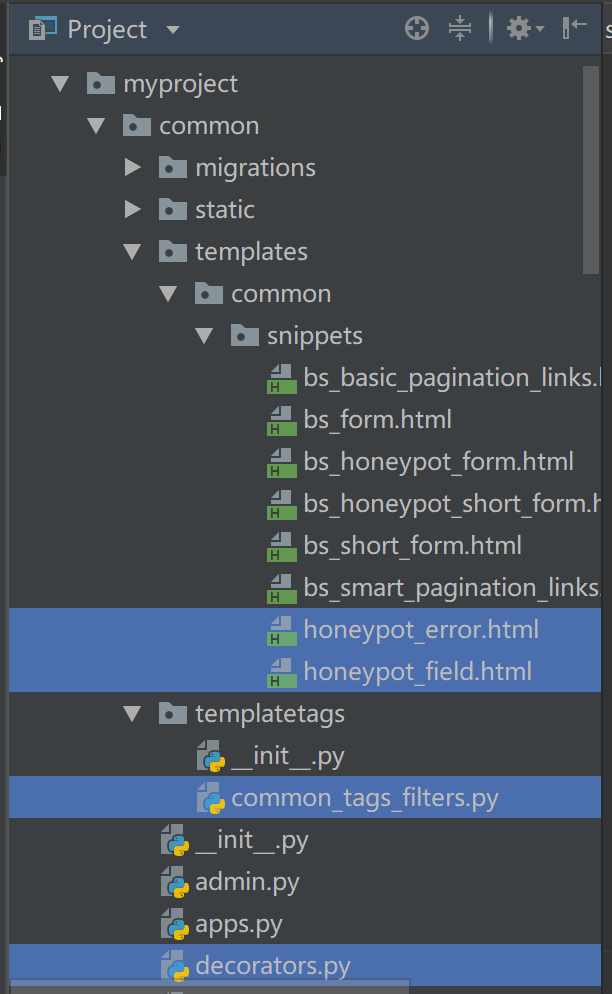жӮЁеҘҪпјҢзҷ»еҪ•еҗҺжүҚиғҪдёӢи®ўеҚ•е“ҰпјҒ
жӮЁеҘҪпјҢзҷ»еҪ•еҗҺжүҚиғҪдёӢи®ўеҚ•е“ҰпјҒ
иҝҷзҜҮж–Үз« з»ҷеӨ§е®¶д»Ӣз»ҚдҪҝз”ЁDjangoжҖҺд№Ҳз»ҷиЎЁеҚ•ж·»еҠ honeypotйӘҢиҜҒпјҢеҶ…е®№йқһеёёиҜҰз»ҶпјҢж„ҹе…ҙи¶Јзҡ„е°Ҹдјҷдјҙ们еҸҜд»ҘеҸӮиҖғеҖҹйүҙпјҢеёҢжңӣеҜ№еӨ§е®¶иғҪжңүжүҖеё®еҠ©гҖӮ
HoneypotеҸҲеҗҚиңңзҪҗпјҢе…¶е®һжң¬иҙЁдёҠжҳҜз§Қйҷ·йҳұгҖӮжҲ‘们еңЁиЎЁеҚ•дёӯж•…ж„ҸйҖҡиҝҮCSSйҡҗи—ҸдёҖдәӣеӯ—ж®ө, иҝҷдәӣеӯ—ж®өдёҖиҲ¬дәәжҳҜдёҚеҸҜи§Ғзҡ„гҖӮ然иҖҢжңәеҷЁдәәжҲ–зЁӢеәҸдјҡд»Ҙдёәиҝҷдәӣеӯ—ж®өд№ҹжҳҜеҝ…йңҖзҡ„еӯ—ж®ө(required), жүҖд»ҘдјҡиЎҘе…ЁеҗҺжҸҗдәӨиЎЁеҚ•пјҢиҝҷе°ұдёӯдәҶжҲ‘们зҡ„йҷ·йҳұгҖӮеңЁи§ҶеӣҫдёӯжҲ‘们еҸҜд»ҘйҖҡиҝҮиЈ…йҘ°еҷЁеҜ№з”ЁжҲ·жҸҗдәӨзҡ„иЎЁеҚ•ж•°жҚ®иҝӣиЎҢеҲӨж–ӯпјҢжқҘйӘҢиҜҒиЎЁеҚ•зҡ„еҗҲжі•жҖ§гҖӮжҜ”еҰӮhoneypotеӯ—ж®өжң¬жқҘеә”иҜҘдёәз©әзҡ„пјҢзҺ°еңЁеұ…然жңүеҶ…е®№дәҶпјҢжҳҫ然иҝҷжҳҜжңәеҷЁдәәжҲ–зЁӢеәҸжҸҗдәӨзҡ„ж•°жҚ®пјҢжҲ‘们еҸҜд»ҘжӢ’з»қе…¶иҜ·жұӮгҖӮ
DjangoиЎЁеҚ•дёӯж·»еҠ honeypotпјҢдёҖе…ұеҲҶдёӨжӯҘпјҡ
1. зј–еҶҷжЁЎжқҝж Үзӯҫ(templatetags)пјҢеңЁеҢ…еҗ«жЁЎжқҝзҡ„иЎЁеҚ•дёӯз”ҹжҲҗhoneypotеӯ—ж®өгҖӮ
2. зј–еҶҷиЈ…йҘ°еҷЁ(decorators.py), еҜ№POSTиҜ·жұӮеҸ‘йҖҒжқҘзҡ„иЎЁеҚ•ж•°жҚ®иҝӣиЎҢйӘҢиҜҒгҖӮ
з”ұдәҺhoneypotзҡ„еҠҹиғҪжүҖжңүappйғҪеҸҜд»Ҙз”ЁеҲ°пјҢжҲ‘们еҲӣе»әдәҶдёҖдёӘеҸ«commonзҡ„appгҖӮж•ҙдёӘйЎ№зӣ®зҡ„зӣ®еҪ•з»“жһ„еҰӮдёӢжүҖзӨәгҖӮеҸӘжңүж Үи“қиүІзҡ„4дёӘж–Ү件пјҢжҳҜдёҺhoneypotзӣёе…ізҡ„гҖӮ

жҲ‘们еңЁcommonзӣ®еҪ•дёӢж–°е»әtemplatetagsзӣ®еҪ•(еҢ…еҗ«дёҖдёӘз©әзҡ„__init__.py)пјҢ然еҗҺеңЁж–°е»әcommon_tags_filters.py, ж·»еҠ еҰӮдёӢд»Јз ҒгҖӮ
from django import template from django.conf import settings from django.template.defaultfilters import stringfilter register = template.Library() # used to render honeypot field @register.inclusion_tag('common/snippets/honeypot_field.html') def render_honeypot_field(field_name=None): """ Renders honeypot field named field_name (defaults to HONEYPOT_FIELD_NAME). """ if not field_name: field_name = getattr(settings, 'HONEYPOT_FIELD_NAME', 'name1') value = getattr(settings, 'HONEYPOT_VALUE', '') if callable(value): value = value() return {'fieldname': field_name, 'value': value}жҲ‘们зҺ°еңЁжқҘзңӢдёӢдёҠйқўиҝҷж®өд»Јз ҒеҰӮдҪ•е·ҘдҪңзҡ„гҖӮжҲ‘们еҲӣе»әдәҶдёҖдёӘеҗҚдёәrender_honeypot_fieldзҡ„жЁЎжқҝж ҮзӯҫпјҢз”ЁдәҺеңЁжЁЎжқҝдёӯз”ҹжҲҗhoneypotеӯ—ж®өгҖӮhoneypotеӯ—ж®өеҗҚжҳҜsettings.pyйҮҢHONEYPOT_FIELD_NAMEпјҢеҰӮжһңжІЎжңүжӯӨйЎ№и®ҫзҪ®пјҢй»ҳи®ӨеҖјдёәname1гҖӮhoneypotеӯ—ж®өзҡ„й»ҳи®ӨеҖјжҳҜHONEYPOT_VALUE, еҰӮжһңжІЎжңүжӯӨйЎ№и®ҫзҪ®пјҢй»ҳи®ӨеҖјдёәз©әеӯ—з¬ҰдёІ''гҖӮ然еҗҺиҝҷдёӘеҮҪж•°е°Ҷfieldnameе’Ңvalueдј йҖ’з»ҷеҰӮдёӢжЁЎжқҝзүҮж®өгҖӮ
# common/snippets/honeypot_field.html
<div class="form-control" > <label><input type="text" name="{{ fieldname }}" value="{{ value }}" /> </label> </div>еңЁDjangoжЁЎжқҝзҡ„иЎЁеҚ•дёӯз”ҹжҲҗhoneypotеӯ—ж®өеҸӘйңҖжҢүеҰӮдёӢж“ҚдҪңпјҡ
{% load common_tags_filters %} {% load static %} <form method="post" action=""> {% csrf_token %} {% render_honeypot_field %} {% form.as_p %} </form>еңЁcommonж–Ү件дёӢж–°е»әdecorators.py, ж·»еҠ еҰӮдёӢд»Јз ҒгҖӮжҲ‘们编еҶҷдәҶcheck_honeypotе’Ңhoneypot_exemptдёӨдёӘиЈ…йҘ°еҷЁпјҢеүҚиҖ…з»ҷйңҖиҰҒеҜ№honeypotеӯ—ж®өиҝӣиЎҢйӘҢиҜҒзҡ„и§ҶеӣҫеҮҪж•°дҪҝз”ЁпјҢеҗҺиҖ…з»ҷдёҚйңҖиҰҒеҜ№honeypotеӯ—ж®өиҝӣиЎҢйӘҢиҜҒзҡ„и§ҶеӣҫеҮҪж•°дҪҝз”ЁгҖӮ
#common/decorators.py
from functools import wraps from django.conf import settings from django.http import HttpResponseBadRequest, HttpResponseForbidden, HttpResponseRedirect from django.template.loader import render_to_string from django.contrib.auth.decorators import user_passes_test def honeypot_equals(val): """ Default verifier used if HONEYPOT_VERIFIER is not specified. Ensures val == HONEYPOT_VALUE or HONEYPOT_VALUE() if it's a callable. """ expected = getattr(settings, 'HONEYPOT_VALUE', '') if callable(expected): expected = expected() return val == expected def verify_honeypot_value(request, field_name): """ Verify that request.POST[field_name] is a valid honeypot. Ensures that the field exists and passes verification according to HONEYPOT_VERIFIER. """ verifier = getattr(settings, 'HONEYPOT_VERIFIER', honeypot_equals) if request.method == 'POST': field = field_name or settings.HONEYPOT_FIELD_NAME if field not in request.POST or not verifier(request.POST[field]): response = render_to_string('common/snippets/honeypot_error.html', {'fieldname': field}) return HttpResponseBadRequest(response) def check_honeypot(func=None, field_name=None): """ Check request.POST for valid honeypot field. Takes an optional field_name that defaults to HONEYPOT_FIELD_NAME if not specified. """ # hack to reverse arguments if called with str param if isinstance(func, str): func, field_name = field_name, func def wrapper(func): @wraps(func) def inner(request, *args, **kwargs): response = verify_honeypot_value(request, field_name) if response: return response else: return func(request, *args, **kwargs) return inner if func is None: def decorator(func): return wrapper(func) return decorator return wrapper(func) def honeypot_exempt(func): """ Mark view as exempt from honeypot validation """ # borrowing liberally from django's csrf_exempt @wraps(func) def wrapper(*args, **kwargs): return func(*args, **kwargs) wrapper.honeypot_exempt = True return wrapperдёҠйқўд»Јз ҒжңҖйҮҚиҰҒзҡ„е°ұжҳҜverify_honeypot_valueеҮҪж•°дәҶгҖӮеҰӮжһңз”ЁжҲ·йҖҡиҝҮPOSTж–№ејҸжҸҗдәӨзҡ„иЎЁеҚ•йҮҢжІЎжңүhoneypotеӯ—ж®өжҲ–иҜҘеӯ—ж®өзҡ„еҖјдёҚзӯүдәҺsettings.pyдёӯзҡ„й»ҳи®ӨеҖјпјҢеҲҷйӘҢиҜҒеӨұиҙҘ并иҝ”еӣһеҰӮдёӢй”ҷиҜҜпјҡ
# common/snippets/honeypot_error.html
<!DOCTYPE html> <html lang="en"> <body> <h2>400 Bad POST Request</h2> <p>We have detected a suspicious request. Your request is aborted.</p> </body> </html>
е®ҡд№үеҘҪиЈ…йҘ°еҷЁеҗҺпјҢжҲ‘们еҜ№йңҖиҰҒеӨ„зҗҶPOSTиЎЁеҚ•зҡ„и§ҶеӣҫеҮҪж•°еҠ дёҠ@check_honeypotе°ұиЎҢдәҶпјҢжҳҜдёҚжҳҜеҫҲз®ҖеҚ•пјҹ
from common.decorators import check_honeypot @check_honeypot def signup(request): if request.method == "POST": form = SignUpForm(request.POST) if form.is_valid(): user = form.save() login(request, userпјү return HttpResponseRedirect(reverse('users:profile')) else: form = SignUpForm() return render(request, "users/signup.html", {"form": form, })е…ідәҺдҪҝз”ЁDjangoжҖҺд№Ҳз»ҷиЎЁеҚ•ж·»еҠ honeypotйӘҢиҜҒе°ұеҲҶдә«еҲ°иҝҷйҮҢдәҶпјҢеёҢжңӣд»ҘдёҠеҶ…е®№еҸҜд»ҘеҜ№еӨ§е®¶жңүдёҖе®ҡзҡ„её®еҠ©пјҢеҸҜд»ҘеӯҰеҲ°жӣҙеӨҡзҹҘиҜҶгҖӮеҰӮжһңи§үеҫ—ж–Үз« дёҚй”ҷпјҢеҸҜд»ҘжҠҠе®ғеҲҶдә«еҮәеҺ»и®©жӣҙеӨҡзҡ„дәәзңӢеҲ°гҖӮ
е…ҚиҙЈеЈ°жҳҺпјҡжң¬з«ҷеҸ‘еёғзҡ„еҶ…е®№пјҲеӣҫзүҮгҖҒи§Ҷйў‘е’Ңж–Үеӯ—пјүд»ҘеҺҹеҲӣгҖҒиҪ¬иҪҪе’ҢеҲҶдә«дёәдё»пјҢж–Үз« и§ӮзӮ№дёҚд»ЈиЎЁжң¬зҪ‘з«ҷз«ӢеңәпјҢеҰӮжһңж¶үеҸҠдҫөжқғиҜ·иҒ”зі»з«ҷй•ҝйӮ®з®ұпјҡis@yisu.comиҝӣиЎҢдёҫжҠҘпјҢ并жҸҗдҫӣзӣёе…іиҜҒжҚ®пјҢдёҖз»ҸжҹҘе®һпјҢе°Ҷз«ӢеҲ»еҲ йҷӨж¶үе«ҢдҫөжқғеҶ…е®№гҖӮ